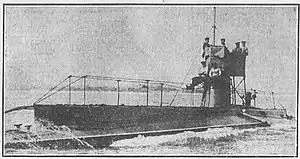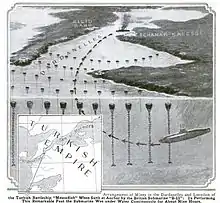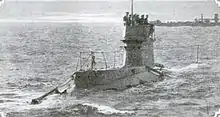HMS B11
HMS B11 was the last of 11 B-class submarines built for the Royal Navy in the first decade of the 20th century. Completed in 1906, it is best known for carrying out a successful attack on the Ottoman battleship Mesûdiye in the Dardanelles, an action for which her captain received the Victoria Cross. It spent the remainder of its active life serving in the Mediterranean, being converted into a surface patrol boat late in the war. B11 was sold for scrap in 1919.
 B11 with crew in 1914 | |
| History | |
|---|---|
| Name | B11 |
| Builder | Vickers |
| Launched | 1906 |
| Fate | Sold for scrap, 1919 |
| General characteristics | |
| Class and type | B-class submarine |
| Displacement | |
| Length | 142 ft 3 in (43.4 m) |
| Beam | 12 ft 7 in (3.8 m) |
| Draught | 11 ft 2 in (3.4 m) |
| Installed power | |
| Propulsion |
|
| Speed |
|
| Range | 1,000 nmi (1,900 km; 1,200 mi) at 8.7 knots (16.1 km/h; 10.0 mph) on the surface |
| Test depth | 100 feet (30.5 m) |
| Complement | 2 officers and 13 ratings |
| Armament | 2 × 18 in (450 mm) bow torpedo tubes |
Design and description
The B class was an enlarged and improved version of the preceding A class. The submarines had a length of 142 feet 3 inches (43.4 m) overall, a beam of 12 feet 7 inches (3.8 m) and a mean draft of 11 feet 2 inches (3.4 m). They displaced 287 long tons (292 t) on the surface and 316 long tons (321 t) submerged. The B-class submarines had a crew of two officers and thirteen ratings.[1]
For surface running, the boats were powered by a single 16-cylinder 600-brake-horsepower (447 kW) Vickers petrol engine that drove one propeller shaft. When submerged the propeller was driven by a 180-horsepower (134 kW) electric motor. They could reach 12 knots (22 km/h; 14 mph) on the surface and 6.5 knots (12.0 km/h; 7.5 mph) underwater.[1] On the surface, the B class had a range of 1,000 nautical miles (1,900 km; 1,200 mi) at 8.7 knots (16.1 km/h; 10.0 mph).[2]
The boats were armed with two 18-inch (450 mm) torpedo tubes in the bow. They could carry a pair of reload torpedoes, but generally did not as they would have to remove an equal weight of fuel in compensation.[3]
Pre-war career
The submarine was constructed by Vickers in Barrow and was launched on 24 February 1906. Fitting out was completed 11 July the same year. Along with HMS B9 and HMS B10 the submarine was deployed to Malta in 1912.[4]
World War I service
Patrolling off the Dardanelles
In September 1914 the submarine was redeployed to Tenedos join the fleet watching the entrance of the Dardanelles.[5] Later in 1914 while on patrol off the Dardanelles, B11 chased a torpedo boat for 4 miles up the strait.[6]
In April 1915 after HMS E15 ran aground off Kephez point, B11 was one of a number of boats that failed in their attempts to destroy the wreck. On 20 May the boat sighted SM UB-8 while on patrol off the Gulf of Smyrna. The submarine attempted to attack but was spotted and UB-8 then dived before escaping.[7]
Attack on the Mesudiye

On 13 December 1914, B11, commanded by Lieutenant Norman Douglas Holbrook, entered the Dardanelles and torpedoed the Ottoman battleship Mesûdiye. The submarine had been selected for the mission over HMS B9 and HMS B10 due to having been fitted with a new battery.[6] The French boats at the submarine base had been rejected as it was agreed that they were less suitable than the British submarines. Guards were constructed over the various projections on the submarine's hull to reduce the risk of snagging on mines.[8]
B11 started its journey from Tenedos.[9] Before the submarine reached the first row of mines it was discovered that one of the guards had become damaged making it worse than useless. The guard was removed and the attack continued.[10] The boat then had to pass under five rows of mines through then uncharted currents. Passing through the minefield took about five hours. After B11 hit Mesûdiye it took eight hours for the submarine to escape initially with any attempt to use the periscope resulting in heavy fire.[9]

Lt. Holbrook was awarded the Victoria Cross, the first for service in a submarine, his First Lieutenant, Sydney Winn, was awarded the Distinguished Service Order, and every member of the crew was awarded the Distinguished Service Medal. On 24 July 1916 the Prize court decided that the submarine's company was entitled to prize money for the sinking of Mesûdiye, and an award of £3,500 was made, of which Holbrook received £601 10s 2d, Winn £481 4s 2d, chief petty officers £240 12s 1d, and seamen £120 6s 1d. This represented three years' pay for a seaman.[6] On 24 August 1915 the town of Germanton in New South Wales, Australia, was renamed "Holbrook" in his honour and a replica of B11 can be seen there.
Move to Venice

The submarine was relocated from Malta to Venice in October 1915 arriving on the 28th. On 11 December of the same year the submarine under the command of Lieutenant Samuel Gravener was engaged by an Austrian flying boat. The attack was unsuccessful and the plane suffered engine failure forcing it to land. Gravener attempted attack the plane with a Maxim gun but it jammed and the plane was able to take off again before the submarine could ram it.[11]
On 17 January 1916 the submarine managed to capture the crew of an Austrian flying boat after the aircraft had suffered engine failure while returning from a bombing raid. On 17 March she was narrowly missed by a torpedo but was unable to locate the attacker.[12] Later in the war B11 was converted to a surface patrol boat by raising the deck level and removing the electric motor. In addition the conning tower was replaced by a wheelhouse.[13] B11 was sold for scrap in 1919 in Italy.[4]
Notes
- Gardiner & Gray (1985), p. 87
- Akermann (1989), p. 123.
- Harrison (1979), Chapter 27.
- Akermann (1989), pp. 123–125.
- Wilson & Kemp (1997), p. 17.
- Compton-Hall (2004), pp. 155–162
- Wilson & Kemp (1997), pp. 54, 75.
- Gray (1971), pp. 96, 98.
- Jameson (1965), pp. 139–141
- Gray (1971), p. 98.
- Wilson & Kemp (1997), pp. 96, 98.
- Wilson & Kemp (1997), pp. 98, 100.
- Cocker (2008), p. 24
References
- Akermann, Paul (2002). Encyclopaedia of British Submarines 1901–1955 (reprint of the 1989 ed.). Penzance, Cornwall: Periscope Publishing. ISBN 1-904381-05-7.
- Cocker, Maurice (2008). Royal Navy Submarines 1901 to the Present Day. Pen & Sword Books. ISBN 978-1-84415-733-4.
- Compton-Hall, Richard (2004). Submarines at War 1914–18. Periscope Publishing. ISBN 1-904381-21-9.
- Gardiner, Robert & Gray, Randal, eds. (1985). Conway's All the World's Fighting Ships 1906–1921. Annapolis, Maryland: Naval Institute Press. ISBN 0-85177-245-5.
- Gray, Edwyn (1971). British Submarines in the Great War. Charles Schribner Sons. ISBN 0-85052-776-7.
- Harrison, A. N. (January 1979). "The Development of HM Submarines From Holland No. 1 (1901) to Porpoise (1930) (BR3043)". United Kingdom Ministry of Defence. Retrieved 16 September 2019 – via RN Subs.
- Jameson, William (1965). The Most Formidable Thing The Story of the Submarine for its earliest days to the end of World War I. Rupert Hart-Davis.
- Kemp, Paul & Jung, Peter (1989). "Five Broken Down B Boats: British Submarine Operations in the Northern Adriatic 1915–1917". Warship International. XXVI (1): 10–29. ISSN 0043-0374.
- Wilson, Michael & Kemp, Paul (1997). Mediterranean Submarines. Crécy Publishing. ISBN 0-947554-57-2.
External links
- B11 on britsub.net Archived 27 September 2007 at the Wayback Machine
- Holbrook and Submarines - The Connection - online version of booklet published by The Submarine Museum on Holbrook and his act of gallantry. Includes list of crew members and copious other information.